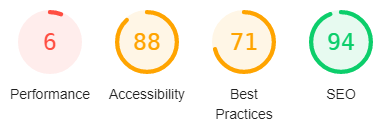This community site is made with GRAV, using the Quark theme with a custom.css:
I have always worked with Drupal, but I like Grav a LOT more.
BTW, the site is in Dutch, but can be read in English and Spanish.
Hope you like what you see.
This community site is made with GRAV, using the Quark theme with a custom.css:
I have always worked with Drupal, but I like Grav a LOT more.
BTW, the site is in Dutch, but can be read in English and Spanish.
Hope you like what you see.
@TonHaarmans, Congrats on your first Grav project.
I think spending some time on performance will serve the site right. It felt slow, so I did some research.
Traffic lights generated by Google Chrome Lighthouse (home page):

Take some time to play with it, it will give you a wealth of suggestions.
Network traffic (home page):
defer
srcset.The build-in ‘honeypot’ strategy to prevent spam on your contact form might be a lightweight and yet effective alternative to reCaptcha.
Thanks a lot for your feedback. I deed some work on the performance of the site and I think it’s a lot faster now. Hope you can confirm this…
@TonHaarmans, Yes there is improvement…

The site uses both statcounter and google analytics. What is the added value of running both?
How often do users use the Google translate option? Is it popular enough to load/run its scripts? NB. The Google Translate element overlays the menu.
Likewise the added Facebook buttons and their required scripts and css.
This is the first time I encounter browser-update.org which is supposed to notify users when they do not use the latest version of their browser.
Although, I haven’t found any malware warnings on the web, I wonder if this is really such an important plugin to run on every page on every visit.
Would you feel OK when out of the blue a site offers you to install the latest version of your browser? No thank you… I wouldn’t.
I see a bunch of scripts of which I do not understand the purpose. Two examples:
.listen('a[rel="lightbox"], but there is no anchor with rel="lightbox" on the page.$(".slider .gallery-container"), but there is no element with class ‘slider’Just my 2 cents…
Thanks again! I will look into these issues asap. Concerning the scripts, they are not used on the home page, but on other pages. I don’t know how to keep scripts that are declared on base.html.twig from running on pages where they shouldn’t work…Perhaps you do?
@TonHaarmans, There are multiple approaches I can think of to enable/disable plugins.
lightslider.md
mytemplate.md. The template could then add css/js to the page.contactform: enable: true and read in Twig: {% if page.header.comments.enable %}
{% if grav.config.myconfig.comments.route == page.url %} or{% if grav.config.plugins.comments.route == page.url %}
Great, thanks again. I’ll have a look. You might have guessed, I’m actually a noob with Grav…
@TonHaarmans, Someone who launches a functional website build from scratch with Grav, can hardly be called a noob…